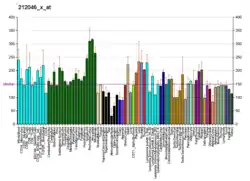MAPK3
Mitogen-activated protein kinase 3, also known as p44MAPK and ERK1,[5] is an enzyme that in humans is encoded by the MAPK3 gene.[6]
Function
The protein encoded by this gene is a member of the mitogen-activated protein kinase (MAP kinase) family. MAP kinases, also known as extracellular signal-regulated kinases (ERKs), act in a signaling cascade that regulates various cellular processes such as proliferation, differentiation, and cell cycle progression in response to a variety of extracellular signals. This kinase is activated by upstream kinases, resulting in its translocation to the nucleus where it phosphorylates nuclear targets. Alternatively spliced transcript variants encoding different protein isoforms have been described.[7]
Clinical significance
It has been suggested that MAPK3, along with the gene IRAK1, is turned off by two microRNAs that were activated after the influenza A virus had been made to infect human lung cells.[8]
Signaling pathways
Pharmacological inhibition of ERK1/2 restores GSK3β activity and protein synthesis levels in a model of tuberous sclerosis.[9]
Interactions
MAPK3 has been shown to interact with:
References
- GRCh38: Ensembl release 89: ENSG00000102882 - Ensembl, May 2017
- GRCm38: Ensembl release 89: ENSMUSG00000063065 - Ensembl, May 2017
- "Human PubMed Reference:". National Center for Biotechnology Information, U.S. National Library of Medicine.
- "Mouse PubMed Reference:". National Center for Biotechnology Information, U.S. National Library of Medicine.
- Thomas, Gareth M.; Huganir, Richard L. (1 March 2004). "MAPK cascade signalling and synaptic plasticity". Nature Reviews Neuroscience. 5 (3): 173–183. doi:10.1038/nrn1346. ISSN 1471-003X. PMID 14976517. S2CID 205499891.
- García F, Zalba G, Páez G, Encío I, de Miguel C (15 May 1998). "Molecular cloning and characterization of the human p44 mitogen-activated protein kinase gene". Genomics. 50 (1): 69–78. doi:10.1006/geno.1998.5315. PMID 9628824.
- "Entrez Gene: MAPK3 mitogen-activated protein kinase 3".
- Buggele WA, Johnson KE, Horvath CM (2012). "Influenza A virus infection of human respiratory cells induces primary microRNA expression". J. Biol. Chem. 287 (37): 31027–40. doi:10.1074/jbc.M112.387670. PMC 3438935. PMID 22822053.
- Pal R, Bondar VV, Adamski CJ, Rodney GG, Sardiello M (2017). "Inhibition of ERK1/2 Restores GSK3β Activity and Protein Synthesis Levels in a Model of Tuberous Sclerosis". Sci. Rep. 7 (1): 4174. doi:10.1038/s41598-017-04528-5. PMC 5482840. PMID 28646232.
- Todd JL, Tanner KG, Denu JM (May 1999). "Extracellular regulated kinases (ERK) 1 and ERK2 are authentic substrates for the dual-specificity protein-tyrosine phosphatase VHR. A novel role in down-regulating the ERK pathway". J. Biol. Chem. 274 (19): 13271–80. doi:10.1074/jbc.274.19.13271. PMID 10224087.
- Muda M, Theodosiou A, Gillieron C, Smith A, Chabert C, Camps M, Boschert U, Rodrigues N, Davies K, Ashworth A, Arkinstall S (April 1998). "The mitogen-activated protein kinase phosphatase-3 N-terminal noncatalytic region is responsible for tight substrate binding and enzymatic specificity". J. Biol. Chem. 273 (15): 9323–9. doi:10.1074/jbc.273.15.9323. PMID 9535927.
- Kim DW, Cochran BH (February 2000). "Extracellular signal-regulated kinase binds to TFII-I and regulates its activation of the c-fos promoter". Mol. Cell. Biol. 20 (4): 1140–8. doi:10.1128/mcb.20.4.1140-1148.2000. PMC 85232. PMID 10648599.
- Zhou X, Richon VM, Wang AH, Yang XJ, Rifkind RA, Marks PA (December 2000). "Histone deacetylase 4 associates with extracellular signal-regulated kinases 1 and 2, and its cellular localization is regulated by oncogenic Ras". Proc. Natl. Acad. Sci. U.S.A. 97 (26): 14329–33. doi:10.1073/pnas.250494697. PMC 18918. PMID 11114188.
- Marti A, Luo Z, Cunningham C, Ohta Y, Hartwig J, Stossel TP, Kyriakis JM, Avruch J (January 1997). "Actin-binding protein-280 binds the stress-activated protein kinase (SAPK) activator SEK-1 and is required for tumor necrosis factor-alpha activation of SAPK in melanoma cells". J. Biol. Chem. 272 (5): 2620–8. doi:10.1074/jbc.272.5.2620. PMID 9006895.
- Butch ER, Guan KL (February 1996). "Characterization of ERK1 activation site mutants and the effect on recognition by MEK1 and MEK2". J. Biol. Chem. 271 (8): 4230–5. doi:10.1074/jbc.271.8.4230. PMID 8626767.
- Elion EA (September 1998). "Routing MAP kinase cascades". Science. 281 (5383): 1625–6. doi:10.1126/science.281.5383.1625. PMID 9767029. S2CID 28868990.
- Yung Y, Yao Z, Hanoch T, Seger R (May 2000). "ERK1b, a 46-kDa ERK isoform that is differentially regulated by MEK". J. Biol. Chem. 275 (21): 15799–808. doi:10.1074/jbc.M910060199. PMID 10748187.
- Zheng CF, Guan KL (November 1993). "Properties of MEKs, the kinases that phosphorylate and activate the extracellular signal-regulated kinases". J. Biol. Chem. 268 (32): 23933–9. PMID 8226933.
- Pettiford SM, Herbst R (February 2000). "The MAP-kinase ERK2 is a specific substrate of the protein tyrosine phosphatase HePTP". Oncogene. 19 (7): 858–69. doi:10.1038/sj.onc.1203408. PMID 10702794.
- Saxena M, Williams S, Taskén K, Mustelin T (September 1999). "Crosstalk between cAMP-dependent kinase and MAP kinase through a protein tyrosine phosphatase". Nat. Cell Biol. 1 (5): 305–11. doi:10.1038/13024. PMID 10559944. S2CID 40413956.
- Saxena M, Williams S, Brockdorff J, Gilman J, Mustelin T (April 1999). "Inhibition of T cell signaling by mitogen-activated protein kinase-targeted hematopoietic tyrosine phosphatase (HePTP)". J. Biol. Chem. 274 (17): 11693–700. doi:10.1074/jbc.274.17.11693. PMID 10206983.
- Roux PP, Richards SA, Blenis J (July 2003). "Phosphorylation of p90 ribosomal S6 kinase (RSK) regulates extracellular signal-regulated kinase docking and RSK activity". Mol. Cell. Biol. 23 (14): 4796–804. doi:10.1128/mcb.23.14.4796-4804.2003. PMC 162206. PMID 12832467.
- Zhao Y, Bjorbaek C, Moller DE (November 1996). "Regulation and interaction of pp90(rsk) isoforms with mitogen-activated protein kinases". J. Biol. Chem. 271 (47): 29773–9. doi:10.1074/jbc.271.47.29773. PMID 8939914.
- Mao C, Ray-Gallet D, Tavitian A, Moreau-Gachelin F (February 1996). "Differential phosphorylations of Spi-B and Spi-1 transcription factors". Oncogene. 12 (4): 863–73. PMID 8632909.
Further reading
- Peruzzi F, Gordon J, Darbinian N, Amini S (2002). "Tat-induced deregulation of neuronal differentiation and survival by nerve growth factor pathway". J. Neurovirol. 8 Suppl 2 (2): 91–6. doi:10.1080/13550280290167885. PMID 12491158.
- Meloche S, Pouysségur J (2007). "The ERK1/2 mitogen-activated protein kinase pathway as a master regulator of the G1- to S-phase transition". Oncogene. 26 (22): 3227–39. doi:10.1038/sj.onc.1210414. PMID 17496918.
- Ruscica M, Dozio E, Motta M, Magni P (2007), "Modulatory Actions of Neuropeptide y on Prostate Cancer Growth: Role of MAP Kinase/ERK 1/2 Activatio", Modulatory actions of neuropeptide Y on prostate cancer growth: role of MAP kinase/ERK 1/2 activation, Advances In Experimental Medicine And Biology, 604, pp. 96–100, doi:10.1007/978-0-387-69116-9_7, ISBN 978-0-387-69114-5, PMID 17695723





